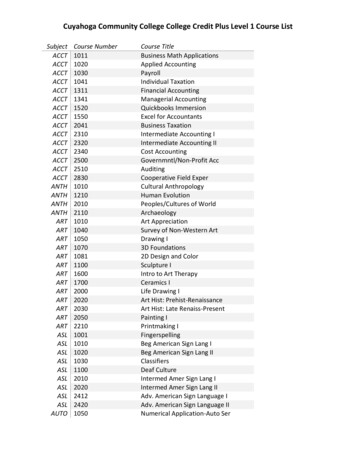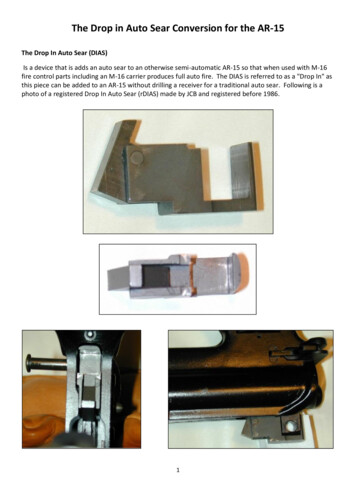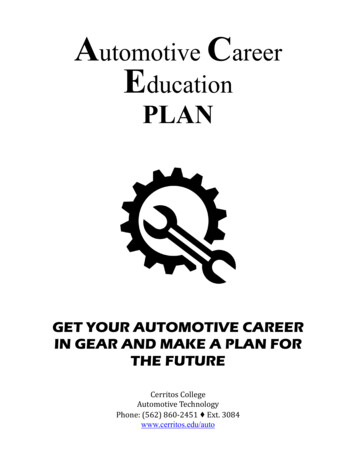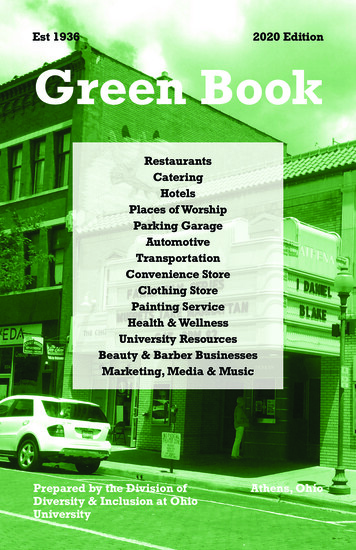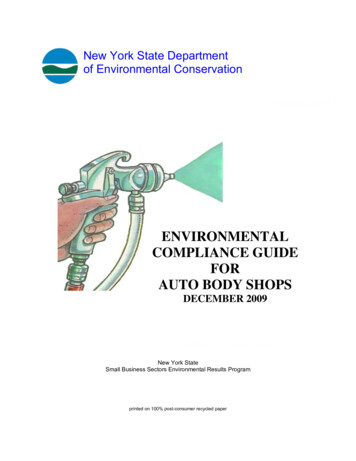
Transcription
New York State Departmentof Environmental ConservationENVIRONMENTALCOMPLIANCE GUIDEFORAUTO BODY SHOPSDECEMBER 2009New York StateSmall Business Sectors Environmental Results Programprinted on 100% post-consumer recycled paper
AcknowledgementsThis guide was developed with assistance from the New York State Environmental Facilities Corporationand Empire State Development. NYSDEC also thanks the New York State Small Business PollutionPrevention/Compliance Assistance Council Members for their contributions to the content of this guide.This guide borrows heavily from existing written materials developed by several other states to addressthe environmental concerns of auto body shops. We would like to recognize the Environmental ResultsPrograms in Massachusetts, Rhode Island, Maine, Delaware, Virginia and Washington. The authorsextend their thanks for the contributions of these other programs to this guide.Please note: Environmental laws and regulations do occasionally change. If there are any regulatorychanges that may affect auto body shops, an updated version of this guide will be posted on the NYSDECwebsite at: www.dec.ny.gov/chemical/54767.html.October 2009 Environmental Compliance Guide for Auto Body Shopsi
Table of ContentsSection 1 - Introduction . 11.11.21.31.41.51.6Who is required to submit the Environmental Report Form? . 1When must the Environmental Report Form be submitted? . 2What benefits does a shop receive by completing the Environmental Report Form?. 2What happens if a shop does not submit the Environmental Report Form? . 2Who can you call for help with the Environmental Report Form or this Guide? . 2Where can you get additional copies of the Environmental Report Form? . 2Section 2 - Pollution Prevention and Energy Efficiency for Auto Body Shops . 32.1 Pollution Prevention . 32.2 Energy Efficiency . 5Section 3 - Common Auto Body Shop Wastes . 7Absorbents and Floor Dry . 7Aerosol Cans . 7Antifreeze . 7Brake Fluids . 7Car Prep and Body Work Wastes . 7“Empty” Containers . 7Gasoline . 7Lead Acid Batteries . 8Mercury Containing (Fluorescent) Lamps . 8Paint Booth Filters . 9Paint Waste. 9Shop Towels . 9Solid Waste . 10Solvents . 10Solvent Distillation Still Bottoms . 10Used Electronics . 10Used Oil . 11Used Oil Filters . 12Waste Tires . 13Section 4 - Air Pollution. 154.1 Exemptions from Part 201 and Part 228 and Subpart 6H . 154.2 Subpart 6H Requirements . 174.3 Record Keeping Requirements . 194.4 Compliant Coatings Requirements . 194.5 Requirements for Controlling Dust and Odor from Sanding and Painting. 204.6 Requirements for Minimizing Fumes, VOCs, and HAPs from Paints and Solvents . 204.7 Spray Gun Requirements . 204.8 Requirements for Cleaning Spray Guns, Metal Parts and Equipment . 214.9 Subpart 6H Spray Booth Requirements . 214.10 Subpart 6H Filter Requirements . 214.11 Subpart 6H Training Requirements . 224.12 Requirements for Servicing Vehicle Air Conditioning Systems . 22October 2009 Environmental Compliance Guide for Auto Body Shopsii
Section 5 - Hazardous Waste . 235.15.25.35.45.55.6What is Hazardous Waste? . 23Determining How Much Hazardous Waste Is Generated at Your Shop . 24Determining Your Hazardous Waste Generator Category . 26Requirements for Conditionally Exempt Small Quantity Generators (CESQGs) . 27Best Management Practices for CESQGs. 28Universal Waste . 29Section 6 - Bulk Storage and Spills . 316.1 Petroleum Spill Reporting Requirements . 316.2 Chemical (Hazardous Substances) Spill Reporting Requirements . 316.3 Petroleum and Chemical Bulk Storage Tank Requirements . 316.4 Petroleum and Chemical Storage Tank Registration Requirements . 32Section 7 - Water Pollution. 337.1 Types of Wastewater . 337.2 Wastewater Management Requirements . 337.3 Floor Drains . 357.4 Maintaining Your Wastewater Treatment System . 357.5 Stormwater. 36APPENDICES . 37Appendix A - Resource Guide . 39A.1 - State Agencies . 39A.2 - NYSDEC Regional Offices . 41Appendix B - Air Permits and Registrations . 43B.1 - Determining Whether Your Shop Requires an Air Permit or Registration . 43B.2 - Calculating VOC Emissions . 44Appendix C - Making a Hazardous Waste Determination . 45Appendix D - Hazardous Waste Codes and Sample Manifest Form . 49Appendix E – Small Business Self-Disclosure Policy. 53October 2009 Environmental Compliance Guide for Auto Body Shopsiii
- THIS PAGE INTENTIONALLY LEFT BLANK -October 2009 Environmental Compliance Guide for Auto Body Shopsiv
Section 1 - IntroductionAll auto body shops must comply with many environmental laws and regulations that can be difficult tounderstand and that are often not written for any one particular industry. This guide has been writtenspecifically for the auto body repair industry to help auto body shops understand and comply with theseenvironmental laws and regulations. This guide also provides information regarding best managementpractices, pollution prevention and energy efficiency that can help shops further minimize human healthrisks and environmental impacts, and save money.This guide is also designed to help auto body shops complete a new Environmental Report Form for AutoBody Shops required for most shops under a new program called the Auto Body Shops EnvironmentalResults Program (ERP).The Auto Body Shops ERP applies to shops that perform any of the following automobile refinishingoperations:Collision repair;Vehicle painting, paint stripping or sanding;Body work;Antique auto restoration; and/orStudent training in any of the above areas.A shop is considered an auto body shop even if it does other kinds of work along with auto body work.For example, dealers or general automotive repair shops that also do auto body repair are considered anauto body shop.1.1 Who is required to submit the Environmental Report Form?The Environmental Report Form for Auto Body Shops must be submitted by all auto body shops that:1. generate any hazardous wastes such as some spent solvents, gun cleaner and waste fluorescentlamps; and/or2. that are subject to the New York State air regulations for surface coating processes (6 NYCRRPart 228). A shop is exempt from 6 NYCRR Part 228 only if it complies with ALL of the followingconditions:a. the shop uses a total quantity of no more than 55 gallons of coatings and cleaning solvents onan annual basis. (The shop must retain records of the quantities of coatings and cleaningsolvents used on an annual basis for five years.);b. the shop applies coatings to work areas no larger than 9.0 square feet;c. the shop applies coatings only using high volume low pressure spraying with a maximum cappressure of 10.0 psig;d. the shop cleans spray guns only using techniques that minimize VOC emissions;e. the shop uses only coatings that do not exceed the VOC content limits of 6 NYCRR Section228.8 (these VOC content limits are listed in Section 4.3 of this guide); andf. the shop exhausts emissions into appropriate emission control equipment.Shops that are exempt from 6 NYCRR Part 228, and that do not generate any hazardous waste, are notrequired to submit the Environmental Report Form, however, voluntary submittal of the EnvironmentalReport Form is encouraged. Completing the form will help shops identify and correct areas not incompliance, and enable shops to be better prepared for random inspections by the New York StateDepartment of Environmental Conservation (NYSDEC). Shops may also learn pollution prevention andenergy efficiency practices that may help them to generate less waste and save money.2009 Environmental Compliance Guide for Auto Body Shops1
1.2 When must the Environmental Report Form be submitted?In general, auto body shops will be given approximately 60 days from the mailing date of the form toreturn the completed form to NYSDEC. Shops will be advised of the exact due date of the completed formwhen the Environmental Report Form is mailed to them.1.3 What benefits does a shop receive by completing the Environmental ReportForm?Compliance with environmental regulations is required of all auto body shops. Completing the form willhelp shops identify and correct areas not in compliance, and enable shops to be better prepared forrandom inspections by NYSDEC. Shops may also learn pollution prevention and energy efficiencypractices that may help them to generate less waste and save money. Also, as set forth in NYSDEC’sSmall Business Self Disclosure Policy (see Appendix E), NYSDEC will eliminate or significantly reducepenalties for small businesses that detect, voluntarily disclose and expeditiously correct violationsdiscovered through environmental audits or compliance assistance. Therefore, submitting the form givesshops the ability to correct environmental violations without penalties or with significantly reducedpenalties.1.4 What happens if a shop does not submit the Environmental Report Form?Auto body shops that generate any hazardous waste or that are not exempt from 6 NYCRR Part 228 maybe subject to enforcement action and penalties if they do not submit the Environmental Report Form.1.5 Who can you call for help with the Environmental Report Form or this Guide?If you need any assistance understanding the information provided in this guide or completing theEnvironmental Report Form, please contact the Small Business Environmental Assistance Program(SBEAP) at 1-800-780-7227. SBEAP is a non-regulatory program administered by the New York StateEnvironmental Facilities Corporation, and provides free confidential technical assistance to help smallbusinesses achieve voluntary compliance with environmental regulations.New York State also offers Environmental Ombudsman services to businesses. If your business issubject to an enforcement action by NYSDEC, and you have questions, complaints or disputes regardingthat action, call Empire State Development’s Small Business Environmental Ombudsman (SBEO) toll freeat 1-877-247-2329. SBEO will help determine which permits or registrations you may need, your rightsand responsibilities, which regulations affect your business operations and how to comply with them. AllSBEO services are free and confidential.1.6 Where can you get additional copies of the Environmental Report Form?Additional copies of this form can be obtained from NYSDEC at (518) 402-8629 or from the NYSDECwebsite at: www.dec.ny.gov/chemical/54767.html.A note on inspections:This program does not guarantee that your shop will not be subject to a random inspection, or aninspection prompted by a complaint. Both state and federal environmental agencies have the authority toperform such inspections. These inspections can result in enforcement actions against shops that are notin compliance. Completing the Environmental Report Form will help you identify and correct deficiencies,and prepare your shop in the event of an inspection. Keep a copy of your completed checklist to assistyou in demonstrating compliance with applicable state and federal regulations.2009 Environmental Compliance Guide for Auto Body Shops2
Section 2 - Pollution Prevention and Energy Efficiency for Auto BodyShops2.1 Pollution PreventionPollution prevention means reducing waste and reducing the use of pollutants in your shop. Pollutionprevention (P2) is usually the easiest and cheapest way to protect the environment and maintain a safe,healthy environment for you, your workers, and your neighbors.The following are pollution prevention tips for auto body shops. Be sure you also read the rest of thisguide to understand any steps you must take to be in compliance with New York State and federal law.1. Use less toxic products. Identify the toxic content of your materials by checking the MaterialSafety Data Sheets (MSDSs), product labels, or ask your materials supplier or SBEAP. Use paint and coatings with the lowest volatile organic compound (VOC) content available. VOCsare chemicals that evaporate readily into the air from materials like paints and solvents. VOCscontribute to ground level ozone, which is a public health concern. See Section 4.4 of this guidefor allowable VOC limits. Consider using waterborne primer and basecoat. This technology is becoming more common inauto body shops as a way of replacing solvent-based paint systems. Though additional equipmentis needed, waterborne coating technology can reduce pollution and make workplaces healthier. Ask suppliers for coatings that do not contain toxic metals (chromium, lead, cadmium, nickel, andmanganese Use high-pressure water, or other non-VOC cleaning options to clean coating lines and containerswhen practical. Use non-toxic soaps to clean floors and vehicles instead of hazardous materials. Eliminate methylene chloride paint strippers. The best way to avoid the risks and costs of dealingwith methylene chloride is not to use it. If you have to use a chemical paint stripper, make sure itdoes not contain methylene chloride.2. Minimize waste generation. Keep your shop organized. Label all products and waste containers. Keep inventory small, up to date, and properly stored to avoid having products that expire orbecome obsolete. Make sure materials that expire first, are used first. Assign one person to be responsible for ordering materials and keeping track of inventories. Use computerized mixing systems. Computerized mixing systems allow painters to mix smalleramounts of color and prevent waste when performing smaller jobs. They also provide an easymeans to label excess coating for later use Reuse excess coating. Use leftover paint as an undercoat or primer.3. Use less solvent. Use recycled solvent for gun cleaning. Consider using a solvent distillation unit. Using a solvent distillation unit may help reduce theamount of hazardous waste generated by your shop, and give you a better hazardous wastegenerator status with fewer regulatory requirements. Don’t use solvents to clean hands or skin. Instead, use a commercial soap solution made forpaint cleanup purposes. Reduce your use of solvents for cleaning your paint spray booth. To clean up excess paint,scrape off as much as possible, and then use water-based or low VOC cleaners instead ofconcentrated solvent-based cleaners.2009 Environmental Compliance Guide for Auto Body Shops3
4. Minimize exposures to auto body dust. Close shop doors and windows when sanding to keep dust from being released from your shop. Sand in designated, controlled areas. Use room ventilation and filtration equipment in addition todust collection systems to keep dust from escaping the shop. Use a ventilated sander (dustless vacuum) system. Vacuum units are the best dust-controllingdevices — they can control up to 90% of dust generated from sanding operations. Inspect sanding equipment often. Make sure all collection systems are operating properly with noleaks or blockages in the system.5. Train shop employees. Train employees to keep their work areas clean and to minimize chemical use. Provide training regarding how to properly handle hazardous waste, and the procedures to befollowed in case of spills or emergencies. Train employees to avoid mixing wastes, to use funnels with lids that are kept closed when not inuse, and to prevent spills by not overfilling containers.6. Implement waste reduction and recycling practices. Purchase reusable products and supplies. Purchase items made from recycled material. Use reusable shipping containers and pallets. Recycle office paper, cardboard, glass, plastic and metal. Keep waste streams separated to increase their potential for reuse or recycling.7. Minimize wastewater generated at your shop. Prevent drips and spills from reaching the floor. Clean up spills immediately with shop towels ormops. Never clean spills by hosing them down with water. Never pour solvents or flammable materials down a drain. Perform vehicle work in areas where there are no floor drains. If floor drains are present, sealthem off during work to prevent spills from entering the drains. Never store hazardous materials in areas with unsealed floor drains. Keep all auto body materials (including waste) protected from rainwater, to prevent pollutedrunoff. Brush snow and ice off vehicles before bringing them into the shop for service. Train employees to prevent water pollution as part of their job duties.8. Conserve water. Train employees to use water efficiently. Minimize use of wash water. Use dry floor cleaning methods including sweeping and vacuuming. Sweep floor with a broom orvacuum every day. Use a slightly damp mop for general cleanups, and after sweeping. Consider purchasing a water recycling unit for vehicle washing or wash vehicles at an offsitecommercial car wash.2009 Environmental Compliance Guide for Auto Body Shops4
2.2 Energy EfficiencySaving money is important to all businesses, but especially small businesses, like auto body shops,where the need to stay competitive is crucial for survival. One strategy for maintaining a competitivebusiness is to implement energy efficiency and energy conservation practices. High-profile energyissues, such as the rising cost of oil, have increased everyone’s concern over the stability of our energysources. Conserving your energy usage can help decrease energy demand and pollution generationwhile saving your business money.There are many energy saving things you can do that have little or no cost to you, but can save youhundreds to thousands of dollars every year. You can combine many of the efforts with standardmaintenance projects like replacing light bulbs or buying new office equipment. In addition, many of theimprovements you make have a very quick return on your investment. The following are some energyconservation tips to help you to conserve energy and save money: Turn off lights and equipment when they are not in use. Keep garage doors closed to save on heating and cooling costs. Use programmable thermostats or adjust thermostats when a space is unoccupied. Using aprogrammable thermostat can save you more than 100 in your yearly utility bills. Replace incandescent light bulbs with compact fluorescent bulbs, which last much longer and usemuch less energy. Compact fluorescent bulbs cost about 75 percent less to operate, and last about10 times longer. Clean or replace your air filters in your heating and cooling systems, every three months, or monthlyduring peak heating and cooling periods. During hot weather, use fans to improve air circulation and employee comfort, instead of turning thethermostat down another degree. Each degree of higher temperature can save you about 3 percenton cooling costs. Install an ENERGY STAR ceiling fan to circulate air in summer and pull hot air down in winter. AnENERGY STAR ceiling fan is 20 percent more efficient than standard fans and can save you about 25 per year on running costs, in addition to the money it saves you in heating and cooling. Caulk and weather-strip windows and exterior doors to prevent leaks. Install motion-sensor lighting in areas used infrequently, such as bathrooms or break rooms. Use an energy efficient air compressor that shuts off when charged. Make sure air compressor linesdon’t leak air or oil. Consider using spray booths or prep stations that are insulated and install heat exchangers torecover heat from exhaust. When you buy new electrical equipment (e.g., computers or air conditioners), look for the ENERGYSTAR symbol, which tells you that the equipment is energy efficient. For a complete listing ofproducts, go to www.energystar.gov/products. Partner with the ENERGY STAR for Small Business program. It’s free and they provide unbiasedinformation and support. Go to www.energystar.gov/smallbiz for more information. Check out NYSERDA’S Energy Audit Program at: www.nyserda.org/programs/energyaudit.asp.This program will conduct energy audits for a fee at small businesses and other facilities to helpthem make informed electrical energy decisions and implement energy-efficiency strategies andimprovements that that may yield substantial annual energy savings.2009 Environmental Compliance Guide for Auto Body Shops5
- THIS PAGE INTENTIONALLY LEFT BLANK -2009 Environmental Compliance Guide for Auto Body Shops6
Section 3 - Common Auto Body Shop WastesThe section provides regulatory guidance and some pollution prevention tips for managing wastes thatare commonly generated at auto body shops.Absorbents and Floor DryA hazardous waste determination must be made on all absorbent pads or floor dry material that is used toclean up spills. If your shop has a spill that could be harmful to public health or the environment, you mustcontact NYSDEC immediately at 1-800-457-7362.Aerosol CansAny “empty” aerosol may be put in the garbage. An aerosol can is considered “empty” only if it containsno discernible product. Body shops sometimes generate “non-empty” waste aerosol cans if a tip breaksor the can otherwise becomes inoperable. Materials such as carburetor cleaner, brake cleaner, ordegreasers, can be hazardous. Therefore, for aerosol cans that are not empty, a hazardous wastedetermination must be made before disposal. This determination can be made either by knowledge (i.e.,by using the MSDS) or by laboratory testing. (See Appendix C of this guide.) If the contents arehazardous, the cans must be managed as either hazardous waste or be returned to the manufacturer.AntifreezeAntifreeze may become contaminated with lead, fuel or solvents when circulating through the engine.Therefore, if you are disposing of used antifreeze, a hazardous waste determination must be made.Brake FluidsBrake fluids are considered used oil and can be combined with your used oil as long as they don’t containany solvents, brake cleaners or carburetor cleaners. Brake fluid contaminated with any of these materialscould cause the brake fluid (and used oil) to become hazardous. If your shop still uses brake cleaners inan aerosol can, chances are they may contain chlorinated solvents which are a hazardous waste.Therefore, don’t spray brake cleaner around brake fluid, and consider investing in an aqueous brakecleaning system which will not only be safer for employees, but could save the shop money. Never putbrake fluid down any drain or on the ground.Car Prep and Body Work WastesPaint stripping and sanding operations may generate hazardous waste if the paint being removed has ahigh metals content (this is common in older vehicles and military vehicles), and/or if any solvents used instripping are hazardous (contain F-listed solvents such as toluene, xylene or methyl ethyl ketone). Youmust either apply knowledge or test body work wastes to determine whether they are hazardous waste.“Empty” ContainersPaint cans, disposable paint cups, or any other container, regardless of what it held, may be disposed ofin the trash provided the container is considered “empty”. A container is considered “empty” when asmuch product as possible has been removed by commonly employed practices (pouring, pumping, etc.),so there is no free-flowing liquid, and less than 1” of residue remains on the bottom of the container. Ifyou can still pour liquid out the container, it is not considered empty and may not be placed into the trashuntil after the liquid is removed. The b
AUTO BODY SHOPS DECEMBER 2009 New York State Small Business Sectors Environmental Results Program printed on 100% post-consumer recycled paper. October 2009 Environmental Compliance Guide for Auto Body Shops i Acknowledgements This guide was developed with assistance from the New York State Environmental Facilities Corporation .

